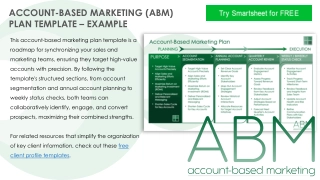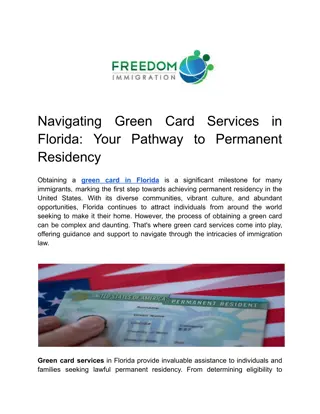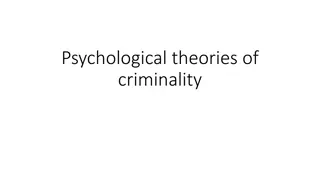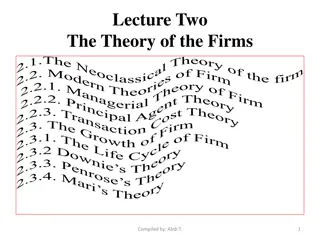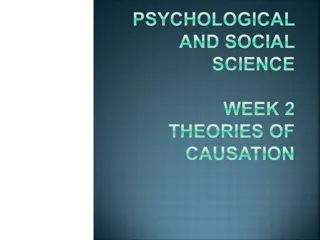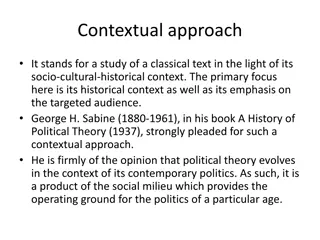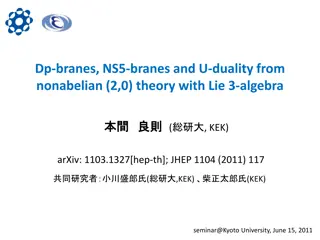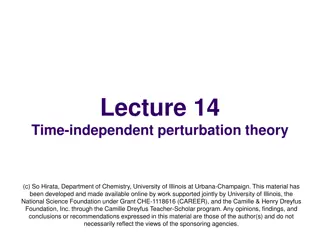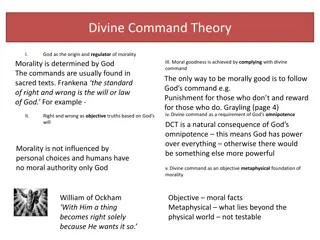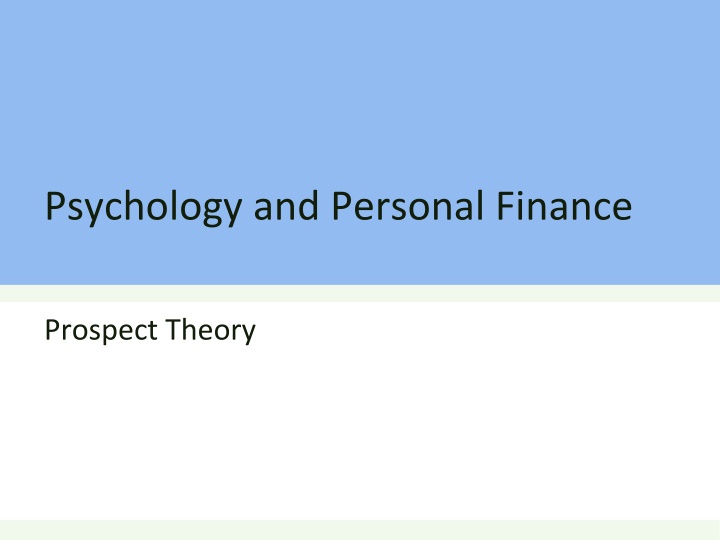
Prospect Theory in Psychology and Personal Finance
Explore the intersection of psychology and personal finance through Prospect Theory in this comprehensive course. Learn about heuristics, biases, spending habits, investment mistakes, retirement planning, and the link between money and happiness. Dive into the world of behavioral finance and witness team presentations showcasing real-life cases and decision-making scenarios.
Download Presentation

Please find below an Image/Link to download the presentation.
The content on the website is provided AS IS for your information and personal use only. It may not be sold, licensed, or shared on other websites without obtaining consent from the author. If you encounter any issues during the download, it is possible that the publisher has removed the file from their server.
You are allowed to download the files provided on this website for personal or commercial use, subject to the condition that they are used lawfully. All files are the property of their respective owners.
The content on the website is provided AS IS for your information and personal use only. It may not be sold, licensed, or shared on other websites without obtaining consent from the author.
E N D
Presentation Transcript
Psychology and Personal Finance Prospect Theory
First, a Video What is this class about? http://befi.allianzgi.com/en/Topics/Pages/save- more-tomorrow.aspx# 2
Course Overview Prospect Theory Heuristics and Biases Sub-Optimal Spending Investment Mistakes Retirement Money and Happiness Behavioral Finance in Action Team Presentations 3
Overview: Todays Lecture Prospect Theory: How do we evaluate risky prospects? 4
Lets Review A Real Episode Case Frank , Netherlands, 1/1/05 6
NO DEAL! What would YOU do? Mean = 383,427 Source: Post, et. al (2008) 7
NO DEAL! What would YOU do? Mean = 64,502 8 Source: Post, et. al (2008)
NO DEAL! What would YOU do? Mean = 85,230 9 Source: Post, et. al (2008)
NO DEAL! What would YOU do? Mean = 95,004 10 Source: Post, et. al (2008)
NO DEAL! What would YOU do? Mean = 85,005 11 Source: Post, et. al (2008)
NO DEAL! What would YOU do? Mean = 102,006 12 Source: Post, et. al (2008)
NO DEAL! What would YOU do? Mean = 2,508 13 Source: Post, et. al (2008)
NO DEAL! What would YOU do? Mean = 3,343 14 Source: Post, et. al (2008)
NO DEAL! What would YOU do? Mean = 5,005 Source: Post, et. al (2008) 15
Deal or No Deal? Why did Frank play they way he did? 16
Prospect Theory Value Function VALUE PLEASURE LOSSES GAINS PAIN REFERENCE POINT Source: Kahneman and Tversky (1979, 1991) 17
Question: Which of these two people is happier right now? Judy has $1,000,000 in her 401(k) and lost $100 bill Dave has $100,000 in his 401(k) and found $100 bill 18
Deal or No Deal Reference Point The Deal or No Deal player makes decisions based on a reference point: The $1,000,000 Case? The banker s offer? $0 (Everything is a gain)? 19
Prospect Theory Recap 1. Reference Point Decisions are made based on the reference point, which can change with time 20
Question: Consider the following bet: I flip a coin either you win $200 or you lose $100. Are you willing to play it for real money right now? Source: Samuelson (1969) 21
Why Do People Reject The Bet? Samuelson s bet is a great investment, since you invest $100 and you either lose it or get $300 back. There is really no risk in losing $100 (other than looking foolish in front of the class). Yet, most people reject the bet. Why? 22
Loss Aversion Losses loom larger than gains The pain of a loss is twice as great as the pleasure of a gain We simply hate to lose even small amounts 23
Prospect Theory Recap 1. Reference Point 2. Loss Aversion The pain of a loss is greater than the pleasure of an equal gain 24
Question: You purchase a stock at $32 and it is now selling at $40. In the next period, it is equally likely that it will increase or decrease by $10. Would you: (A)Sell and realize an $8 gain OR (B)Hold on for a 50/50 shot at another gain or a loss? 25
Question: You purchased stock for $50 and it is now selling at $40. In the next period, it is equally likely that it will increase or decrease by $10. Would you: (A) Sell and realize a $10 loss? OR (B) Hold on for a 50/50 shot at another loss or breaking even? 26
Stock Performance Why does the historical performance of the stock affect your decision? 27
Break Even Effect Losers become more willing to take on risk in an attempt to break even On Deal or No Deal, 56% reject any given deal After bad fortune, rejection increases to 79% Source: Post, et. al (2008) 28
Prospect Theory Continued VALUE RISK AVERSE LOSSES GAINS RISK SEEKING Source: Kahneman and Tversky (1979, 1991) 29
Prospect Theory Recap 1. Reference Point 2. Loss Aversion 3. Break Even Effect When experiencing losses, people tend to exhibit risk seeking behavior to break even 30
Prospect Theory Weighting Function I-Pod Extended Warranty The Lottery Source: Kahneman and Tversky (1979, 1991) 31
Weighting Extremes You are less likely to win a lottery than to die by: Source: http://saneok.org/files/Facts&Stats/LottoFacts.pdf 32
Weighting Extremes Most iPods don t fail within warranty period Would you really want to use the warranty after 3 years why not get a new iPod? http://pileofphotos.com/pics/pic_185222001181678121.jpg http://pileofphotos.com/pics/pic_676676001181678127.jpg 33
Prospect Theory Recap 1. Reference Point 2. Loss Aversion 3. Break Even Effect 4. Overweighting Small Probabilities I can win the lottery! 5. Underweighting Large Probabilities Almost guarantee is not enough! Prospect Theory has even broader implications 34
The Endowment Effect People often demand much more to give up an item than they would pay to acquire it When asked to choose between an iPod and $100, subjects were more likely to choose $100 When given an iPod and asked to trade for $100, most turned down the offer Source: http://www.livescience.com/health/080701-saving-stuff.html 35
Which Line is Longer? The way in which things are framed can influence judgment. Source: http://www.turtletrader.com/heuristics.pdf 36
Which Steak is More Appealing? Source: Levin and Gaeth (1988) 37
Reframing Retirement 75% Rule Exercise One Write down three expenditures you will maintain in retirement. 1. ______________________ 2. ______________________ 3. ______________________ How much of current spending you will maintain in retirement 38
Reframing Retirement 25% Rule Exercise Two Write down three expenditures you will eliminate in retirement. 1. ______________________ 2. ______________________ How much of 3. ______________________ current spending you will eliminate in retirement 39
Prospect Theory Recap 1. Reference Point 2. Loss Aversion 3. Break Even Effect 4. Overweighting Small Probabilities 5. Underweighting Large Probabilities 6. Endowment Effect 7. Framing And Next Class 40
Sum These Numbers OUT LOUD: 1000 10 1000 20 1000 30 1000 40 Is it 5000 . or 4100? Sometimes, heuristics can lead to the wrong answer! 41


